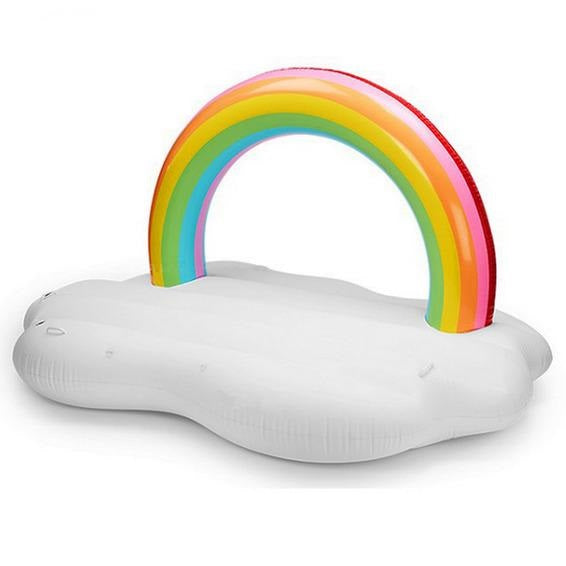The material of pool floats plays a significant role in determining their durability, longevity, and overall performance in the water. Here’s how the material can affect a pool float’s ability to withstand wear and tear, UV exposure, and its ability to provide comfort and safety:

1. Vinyl (PVC)
- Durability: Vinyl is the most common material used for pool floats. It is durable, water-resistant, and provides flexibility. High-quality vinyl floats are usually reinforced with multiple layers, which helps them resist punctures and increases their overall lifespan.
- Resistance to UV Damage: While vinyl is UV-resistant to some extent, prolonged exposure to sunlight can still cause it to fade or crack over time. High-quality vinyl typically includes UV inhibitors, which reduce sun damage.
- Inflation Stability: Vinyl floats tend to hold air well, but over time, with exposure to heat and sunlight, the air inside can expand and contract, causing slight deflation. Premium vinyl options often have better sealing and sturdier valves to prevent leakage.
2. Rubber
- Durability: Rubber is generally more elastic and flexible than vinyl, which can make it more resistant to tearing or popping from punctures. It’s also more abrasion-resistant, so it stands up better to wear from rough surfaces like concrete or rocky pool floors.
- UV and Heat Resistance: Rubber floats can be more resistant to UV radiation than vinyl, making them last longer when exposed to the sun. However, rubber can degrade over time when exposed to high heat, which can cause it to become brittle.
- Air Retention: Rubber tends to hold air well, and natural rubber is less prone to losing air compared to vinyl, making it more durable in the long term.
3. Polyurethane (PU)
- Durability: Polyurethane is another material used for pool floats that is generally lightweight and strong. It is less prone to punctures than vinyl and tends to maintain its shape and air retention for longer periods.
- Resilience: PU is highly flexible, which means it can bend without cracking. This makes it a good option for floats that need to support a lot of weight or frequent use. It's generally more resistant to abrasion compared to vinyl.
- UV Resistance: While polyurethane is more resistant to UV damage than vinyl, it can still degrade under prolonged sun exposure if not treated with UV stabilisers.
4. Nylon
- Durability: Nylon is often used as an outer layer on pool floats, providing an additional layer of protection against punctures and abrasions. When combined with other materials like PVC or rubber, nylon can increase the overall strength of the float, making it more durable.
- Water Resistance: Nylon itself is not as water-resistant as other materials, but it can dry quickly when exposed to water, reducing the chances of mold or mildew forming. This quick-drying feature contributes to its longevity.
- UV Protection: Nylon can fade over time with exposure to the sun, but it’s more resistant to fading compared to some other materials like cotton or synthetic fabrics.
5. Inflatable (Air-Filled) Materials
- Durability: Inflatable pool floats are often made with PVC, rubber, or polyurethane, but the inflation valves and seams also play a crucial role in durability. High-quality floats use stronger seams (such as welded seams) and reliable valves to prevent air leaks and damage.
- Puncture Resistance: Inflatable pool floats are susceptible to punctures from sharp objects like rocks, pool edges, or animal claws. However, some inflatables come with a multi-chamber design (multiple air compartments) to prevent total deflation if one chamber is damaged, offering added durability.
6. Cotton or Fabric Covers
- Durability: Some pool floats, especially loungers, have fabric covers made from cotton or polyester. These materials are less abrasion-resistant but offer greater comfort. They tend to wear out faster than vinyl or rubber but can still last long with proper care.
- UV Resistance: Fabric-covered floats are often prone to fading and UV degradation over time unless they are treated with UV-resistant coatings or designed with marine-grade fabrics.
- Cleaning and Maintenance: Fabric-covered floats are often machine washable or can be spot cleaned, which can help in maintaining their condition. However, fabric can absorb water, which could lead to mildew if not dried properly.
7. Eco-Friendly Materials (Biodegradable or Sustainable Options)
- Durability: Many eco-friendly pool floats are made from materials such as natural rubber, recycled PVC, or biodegradable plastics. These materials tend to be less durable than traditional synthetic materials, although improvements are being made to enhance their longevity and resistance to wear and tear.
- Environmental Impact: While not as durable, eco-friendly floats can be a more sustainable option, especially if they are designed to be easily recyclable or biodegradable when disposed of, which helps reduce long-term environmental damage.
8. Foam Pool Floats
- Durability: Foam floats are extremely durable and long-lasting. They are less prone to punctures, air leaks, or UV degradation, making them ideal for long-term use. Foam is also more resistant to heat and can withstand both high and low temperatures better than inflatable floats.
- Comfort: Foam pool floats are very comfortable as they don’t need inflation, and they provide consistent buoyancy. However, they may be heavier and bulkier compared to inflatable versions.
The material of a pool float is crucial to its durability. Materials like rubber and high-quality vinyl are popular for their balance of durability, flexibility, and air retention, while foam floats are known for their longevity and resistance to punctures. Fabric covers and eco-friendly options may be less durable in harsh conditions but offer comfort and sustainability. When choosing a pool float, consider factors like sun exposure, puncture resistance, and how often the float will be used to ensure it lasts throughout the season.

